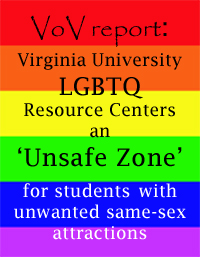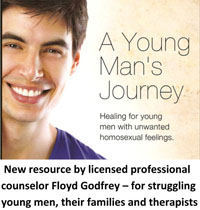NARTH gives the Boy Scouts of America the facts of homosexuality
May 20, 2013
The following excerpts from the article “Research Pertinent to the Boy Scouts of America Policy Change Debate” by Michelle Cretella, M.D. and David C. Pruden, M.S. are reprinted from the NARTH website: … “In keeping with NARTH’s commitment to science and education, NARTH offers the following synopsis of scientific research on homosexuality that may be helpful to the national council of the Boy Scouts of America as it deliberates a change in policy that would allow homosexually-identified youth as members.[1]”
“The development of homosexuality is influenced by environment.
”
“Homosexuality is not an unchangeable biologically determined trait like race. The American Psychological Association reports, ‘There is no consensus among scientists about the exact reasons that an individual develops a heterosexual, bisexual, gay or lesbian orientation. Although much research has examined the possible genetic, hormonal, developmental, social, and cultural influences on sexual orientation, no findings have emerged that permit scientists to conclude that sexual orientation is determined by any particular factor or factors. Many think that nature and nurture both play complex roles…'[2]”
“The environment, including family dynamics, peer interactions and other social factors, can contribute significantly to the formation of one’s sexual orientation. Sexual orientation is not fixed at birth but rather is environmentally influenced and unfolds slowly across childhood, adolescence and even into adulthood for some individuals.[3]”
“Premature sexual identity labeling comes with associated risks for youth.”
“Many teens experience a period of sexual identity ambiguity as a normal stage of adolescent development. The University of Minnesota Hospital & Clinics studied 35,000 students in Minnesota secondary schools. Among the more significant information provided by the survey was the following: At age twelve, 25.9% of the children were ‘unsure’ of their sexual orientation. This figure declined to 5% by age 17, with an average “unsure” for all age groups of 10.7%.[4] If children are encouraged to label themselves “gay,” or adults prematurely reinforce this identity before full psychosocial development has taken place there is a serious risk of erroneously labeling children who were only experiencing temporary sexual confusion.[5]”
“Such premature labeling could lead some adolescents into homosexual behaviors that carry significant risk for serious health consequences, such as, higher rates of sexually transmitted infections, alcoholism, substance abuse, anxiety, depression and suicide.[6]”
“While some might suggest that these heightened risky behaviors are the result of ‘homophobia,’ social prejudice and/or discrimination cannot fully account for the elevated rates of these disorders, since equally dramatic rates are found among youth within homosexually-affirming cultures.[7] Delaying the self-identification of youth as non-heterosexual significantly reduces these medical and psychiatric health risks. For example, researchers find that adolescents who defer “coming out as gay” decrease the risk of suicide at a rate of 20 percent for each year that they delay self-labeling as homosexual or bisexual.[8]”
“[1] http://www.scouting.org/sitecore/content/MembershipStandards/Resolution/Resolution.aspx (accessed May 16, 2013).
[2] American Psychological Association (2008). Answers to your questions: For a better understanding of sexual orientation and homosexuality. Washington, DC: Author.
[3] Whitehead, Neil. My genes made me do it! accessed 5/6/13 from http://www.mygenes.co.nz/download.htm; Collins F. (2007). The language of God: A scientist presents evidence for belief. New York: Free Press, 260 and 263; Langstrom, N., Rahman Q., Carlstrom, E., & Lichtenstein, P. (2008). Genetic and environmental effects on same-sexual behavior: A population study of twins in Sweden. Archives of Sexual Behavior, DOI 10.1007/s10508-008-9386-1; Santilla, P., Sandnabba, N. K., Harlaar, N., Varjonen, M., Alanko, K., & von der Pahlen, B. (2008). Potential for homosexual response is prevalent and genetic. Biological Psychology, 77, 102–105; Bailey, J. M., Dunne, M. P., & Martin, N. G. (2000). Genetic and environmental influences on sexual orientation and its correlates in an Australian twin sample. Journal of Personality and Social Psychology, 78(3), 524–536; Bearman, P. S., & Bruckner, H. (2002). Opposite-sex twins and adolescent same-sex attraction. American Journal of Sociology, 107(5), 1179–1205; Frisch, M., & Hviid, A. (2006). Childhood family correlates of heterosexual and homosexual marriages: A national cohort study to two million Danes. Archives of Sexual Behavior, 35, 533–547.
[4] Demography of Sexual Orientation in Adolescents (April 1992). Pediatrics. The Journal of the American Academy of Pediatrics, 89.
[5] Savin-Williams, R. C., & Ream, G. L. (2007). Prevalence and stability of sexual orientation components during adolescence and young adulthood. Archives of Sexual Behavior, 36, 385–394; Remafedi, G., Resnick, M., Blum, R., & Harris, L. (1992). Demography of sexual orientation in adolescents. Pediatrics, 89, 714–721.
[6] Centers for Disease Control (2010). CDC analysis provides new look at disproportionate impact of HIV and syphilis among U.S. gay and bisexual men. Press Release, Wednesday, March 10, 2010; Urdy, J. R., & Chantala, K. (2005). Risk factors differ according to same-sex and opposite-sex interest. Journal of Biosocial Science, 37, 481–497; Silenzio, V. M. B., Pena, J. B., Duberstein, P. R., Cerel, J., & Knox, K. L. (2007). Sexual orientation and risk factors for suicidal ideation and suicide attempts among adolescents and young adults. American Journal of Public Health, 97(11), 2017–2019; Balsam, K. F., Rothblum, E. D., & Beauchaine, T. P. (2005). Victimization over the life span: A comparison of lesbian, gay, bisexual, and heterosexual siblings. Journal of Consulting and Clinical Psychology, 73(3), 477–487; Nurses’ Health Study II available at www.gaydata.org; Hogg, R. S., Strathdee, S. A., Craib, K. J. P., OShaughnessy, M. V., Montaner, J. S. G., & Schechter, M.T. (1997). Modeling the impact of HIV disease on mortality in gay and bisexual men; Valanis, B. G., Bowen, D. J., Bassford, T., Whitlock, E., Charney, P., & Carter, R. A. (2000). Sexual orientation and health. Archives of Family Medicine, 9, 843–853; Facts About Youth (2010). Health risks of the homosexual lifestyle. Accessed at the Facts website on 5/6/13: http://factsaboutyouth.com/posts/health-risks-of-the-homosexual-lifestyle/
[7] Fergusson, D. M.; Horwood, L. J.; & Beautrais, A. L. (1999). Is sexual orientation related to mental health problems and suicidality in young people? Arch. Gen. Psychiatry, 56, 876–880.
[8]Remafedi, G., Farrow J. A., & Deisher, R.W. (1991). Risk factors for attempted suicide in gay and bisexual youth. Pediatrics, 87, 869–875.”




